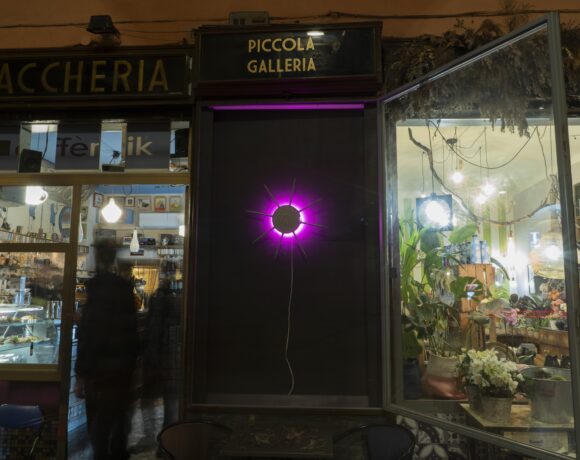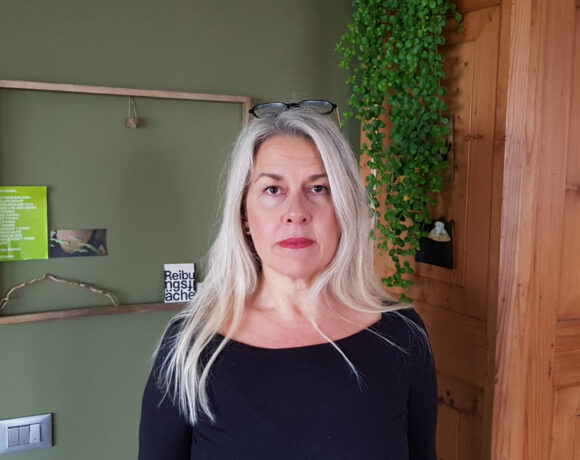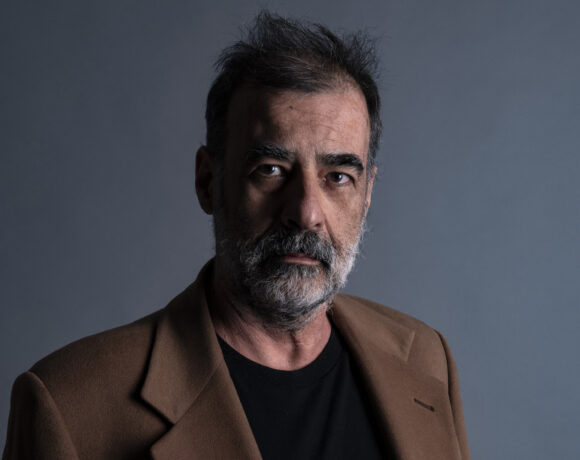We met Light Art Museum Budapest’s artistic director Vida Szabolcs, and we asked some questions to Barnabás Bencsik, one of the curators of the exhibition Superluminal. Introducing the current show, we thought about the museum’s vision, inaugurated in 2022.

“Superluminal”, exhibition view, LAM, Budapest, 2024. Ph. Dávid Bíró, courtesy Light Art Museum Budapest
Sara Buoso: Can you to introduce the exhibition Superluminal?
Barnabás Bencsik: Superluminal is the second exhibition at LAM. The etymology of the term refers to lumen, light as the luminous flux, this suggested the direction for this exhibition. The term is even more interesting because it is taken from a questionable or subversive theory, which states that light is not the fastest physical phenomenon in the universe, which is the consensus of the science based on Albert Einstein’s Relativity Theory. On the contrary, this theory states that there are certain situations in which something faster than light exists, and this exhibition is our personal interpretation of it. We wanted to be critical about established theories and represent artists who work in similar positions both metaphorically and by attitude, with the aim of challenging the present consensus. Superluminal represents this position on a deeper level, by being connected to the phenomena of light and the sun, which are at the center of this show from different perspectives.

Vera Molnár, “OTTWW, Ode to the West Wind”, 1981-2010. Ph. Dávid Bíró, courtesy Light Art Museum Budapest
Which were the criteria behind your choice of works and artists?
LAM is an institution whose mission is light. The physical environment has been created specifically to focus on this phenomenon and it is therefore completely dark: a counter-thesis of the white cube. However, since the museum is located in a protected monument, this determines certain specific constraints for the selection of works, although its architecture allows us to create separate universes, spaces, stories and atmospheres. A second line is the tradition rooted in the legacy of certain Hungarian artists such as László Moholy-Nagy and György Kepes, and those of the Modernist Movement who began to involve artificial light as a medium or material in their creative process. This implies another line: not only do we value light as a phenomenon or medium, but we also value the technology involved in the artistic process. These artists have started to systematically involve new media and new tools coming from science and technology, and we are looking for new ones that represent this same attitude in a poetic, pseudo-scientific or speculative way, on a physical, cultural and symbolic level. Furthermore, for Superluminal, we wanted to play with and mix the digital as a contemporary avant-garde, and the analogue to interpret the phenomenon of light from different positions. Since the discovery of electricity, when we talk about light, we necessarily talk about technology. Ours is a completely new direction in relation to traditional techniques and we must therefore be open to new perspectives. These phenomena are fertilising the aesthetics of arts and technology, designating an artistic position and a new language. The installation White Noise, 2007, by Žilvinas Kempinas, is emblematic in this regard because it refers to analogue. While white noise was normally a phenomenon in the black-and-white cathode ray television of the 1970s and 1980s, the work in question does not depict a television screen but a cinematic situation, even though it is not even a projection as there is no flow of light. It is ambiguous: is it an object or a projected image? It is an intellectual challenge that invites one to lose one’s senses through the two sides of reality. On the borderline between digital and analogue are also the installation Nautilus, 2021, by Žilvinas Kempinas, which takes its cue from the moiré effect in three dimensions, and the work Gifmeister, 2017, by Raumzeitpiraten, which reverses the technologies of film movement between frames and flashes, merging them into a cerebral stroboscopic effect. On the digital research front, the installation Journey, 2019, by Nohlab Utazás, is a fully immersive experience, as is the multimedia installation Multiverse.Unfolded, 2018, by Fuse*, a work derived from the scientific theory of the Multiverse through digital codes and algorithms, a truly impressive visual metaphor on the possibility of thinking of infinite universes in which there is no such thing as an image similar to another. On the other hand, we find an interactive dimension in the work Lumin, 2020, by Ahmet Said Kaplan, which deals with bioluminescence from studies of animals living in the caves of New Zealand; in this view, photosynthesis is at the basis of the practice by translating into forms of interaction. In the same vein, the work Life Support System, 2020, by Disnovation.Org, similarly interrogates the natural and the artificial by emphasising how profoundly we exploit natural resources in terms of sustainability. The commissioned work Uranopathy, 2023, by the duo Sárgany (Barta Bence, Borsos János), is a work on radioactivity, which uses uranium glass to visualise, between UV and gamma rays, a radiation that manifests through the movement of a hammer, which emerges as a musical instrument of the post-apocalyptic period. The question of time is addressed by the work Material Memories, 2023, by Gyula Vàrnai, which is simultaneously analogue and digital using 3D printing; a three-dimensional project on the anthropologisation of objects, drawing their memory between light and shadow, like the drawing of a still life. Szauder David Ariel’s work Modulator V3, 2022, is inspired by László Moholy-Nagy’s iconic Light Prop, a reinterpretation of the original, as a tribute to light as creation. Finally, Clock-Work, 2017, by Attila Csörgő, poses a question on how to represent and connect the two different notions of time: linear and circular time. The artist wanted to create a form that represents this duality and what we see is the shadow of the kinetic structure itself, which is constantly changing: the sign of infinity and the normal clock in a mechanism.

Kit Webster, “Supernova”, 2012, Photo: Dávid Bíró/Light Art Museum Budapest
Regarding these latter works, how important is the legacy of Hungarian artists in the art of light? How do you balance this heritage with innovation and avant-garde approaches?
We have to be aware of the contribution that artists like György Kepes and Nicolas Schöffer have made in this direction and it is important to represent it. That is why some of their works will always be in the museum space. They were involved for the first exhibition in 2022, Light Revolution, and they are present for Superluminal. They will also be for the next opening in summer 2024 but, more generally, we will also consider international artists who have been working in the same direction since the 1960s and 1970s. It is important to show that this approach to light and technology was already present in the artists’ way of thinking, but always subject to the technological circumstances of the time. The mission and vision are similar, which is why we would like to represent both historical and innovative, cutting-edge examples. We want to create a platform for research that looks at the techno-scientific and visual industries, the sector of autonomous creative minds and institutions. These sectors find themselves in completely different circumstances, ecosystems, evaluation systems and canonisations. It is therefore challenging to look for artistic minds in the creative industry that have the potential for autonomous art, but it would be interesting if they could merge and be brought forward together. It is indeed challenging to try to convey messages coming from artistic autonomies through a platform, to ultimately guide our audience.
Info:
various artists, Superluminal
curated by Barnabás Bencsik and Borbála Szalai
06/09/2023 – 23/06/2024
Light Art Museum Budapest
Hold utca 13, 1054 Budapest, Ungheria
hun.lam.xyz

She is interested in the visual, verbal and textual aspects of the Modern Contemporary Arts. From historical-artistic studies at the Cà Foscari University, Venice, she has specialized in teaching and curatorial practice at the IED, Rome, and Christie’s London. The field of her research activity focuses on the theme of Light from the 1950s to current times, ontologically considering artistic, phenomenological and visual innovation aspects.






NO COMMENT